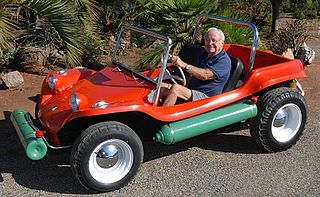
A dune buggy — also known as a beach buggy — is a recreational off-road vehicle with large wheels, and wide tires, designed for use on sand dunes, beaches, off-road or desert recreation. The design is usually a topless vehicle with a rear-mounted engine. A dune buggy can be created by modifying an existing vehicle or custom-building a new vehicle.

The Merkava is a series of main battle tanks used by the Israel Defense Forces (IDF) and the backbone of the IDF's Armored Corps. Current iterations of this tank are considered broadly equivalent to the capabilities of the M1 Abrams, Leopard 2 and the Challenger 2. The current iteration of this vehicle also shares the same MTU EuroPowerPack powerplant as a number of other MBT platforms.

The Cannondale Bicycle Corporation is an American division of Dutch conglomerate Pon Holdings that supplies bicycles. Its headquarters are in Wilton, Connecticut, with engineering offices in Freiburg, Germany. Frames are manufactured in Taiwan. Bikes are assembled in Taiwan, as well as in the USA and in The Netherlands for the local markets.

The M113 is a fully tracked armored personnel carrier (APC) that was developed and produced by the FMC Corporation. The M113 was sent to United States Army Europe in 1961 to replace the mechanized infantry's M59 APCs. The M113 was first used in combat in April 1962 after the United States provided the South Vietnamese army (ARVN) with heavy weaponry such as the M113, under the Military Assistance Command, Vietnam (MACV) program. Eventually, the M113 was the most widely used armored vehicle of the U.S. Army in the Vietnam War and was used to break through heavy thickets in the midst of the jungle to attack and overrun enemy positions. It was largely known as an "APC" or an "ACAV" by the allied forces.

The GMC Motorhome is a recreational vehicle that was manufactured by the GMC Truck & Coach Division of General Motors for model years 1973–1978 in Pontiac, Michigan, USA — as the only complete motorhome built by a major auto/truck manufacturer. Manufactured in 23 and 26 ft lengths, the design was noted for its front-wheel drive and its low profile, fully integrated body.

Body-on-frame, also known as ladder frame construction, is a common motor vehicle construction method, whereby a separate body or coach is mounted on a strong and relatively rigid vehicle frame or chassis that carries the powertrain and to which the wheels and their suspension, brakes, and steering are mounted. While this was the original method of building automobiles, body-on-frame construction is now used mainly for pickup trucks, large SUVs, and heavy trucks.

The Walther P38 is a 9 mm semi-automatic pistol that was developed by Carl Walther GmbH as the service pistol of the Wehrmacht at the beginning of World War II. It was intended to replace the comparatively complex and expensive to produce Luger P08. Moving the production lines to the more easily mass producible P38 once World War II started took longer than expected, leading to the P08 remaining in production until September 1942 and copies remained in service until the end of the war.

Bandvagn 206 is a tracked articulated, all-terrain carrier initially developed and manufactured by the Swedish company Hägglund & Söner, and subsequently by BAE Systems Hägglunds, for the Swedish Army. It consists of two units, with all four tracks powered. It can carry up to 17 people, 6 in the front compartment, 11 in the rear. The trailer unit can be adapted for different uses.

A loading dock or loading bay is an area of a building where goods vehicles are loaded and unloaded. They are commonly found on commercial and industrial buildings, and warehouses in particular. Loading docks may be exterior, flush with the building envelope, or fully enclosed. They are part of a facility's service or utility infrastructure, typically providing direct access to staging areas, storage rooms, and freight elevators.
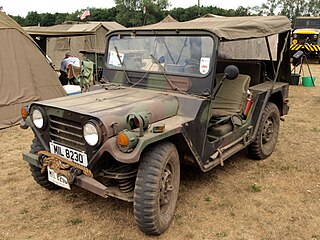
The Truck, Utility, ¼-Ton, 4×4, M151 or simply M151 was the successor to the Korean War M38 and M38A1 Jeep Light Utility Vehicles. The M151 had an integrated body design which offered a little more space than prior jeeps, and featured all-around independent suspension with coil springs. It has since been replaced by the larger AM General HMMWV in most utility roles in frontline use. With some M151A2 units still in U.S. military service in 1999, the M151 series achieved a longer run of service than that of the World War II/Korean War-era MB/GPW, M38, and M38A1 series combined.
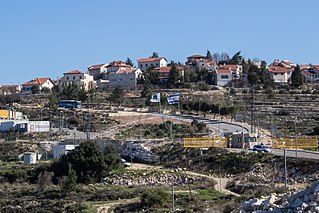
Neve Daniel is an Israeli settlement in the West Bank. Located in western Gush Etzion south of Jerusalem and just west of Bethlehem, it sits atop one of the highest points in the area – close to 1,000 meters above sea level, and has a view of much of the Mediterranean coastal plain, as well as the mountains of Jordan. In 2021, it had a population of 2,360. It is organised as a community settlement and falls under the jurisdiction of Gush Etzion Regional Council.

The Willys MD, formally the M38A1 Truck, Utility: 1/4 ton, 4x4, or the G‑758 by its U.S. Army Standard Nomenclature supply catalog designation, was a four-wheel drive, military light utility vehicle, made by Willys and Willys Motors / Kaiser Jeep from 1952 to 1971. It was widely procured by the U.S. military from 1952 until 1957, after which U.S. purchases were reduced to the U.S. Marine Corps. The Marine version had minor differences from the units used by other branches.
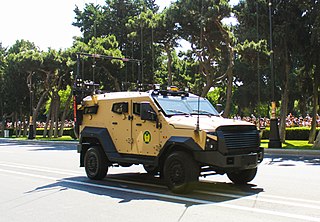
The SandCat is a composite armored vehicle designed by the then Plasan Sasa of Israel. The SandCat was shown publicly for the first time at AUSA during October 2005. The latest models were shown for the first time at Eurosatory 2018. The SandCat is based on a commercial Ford F-Series chassis. Approximately 700 SandCats have been produced since 2004, and while Plasan has never released complete details, these are known to be in service with at least 16 users across five continents, and in a wide variety of roles that range from Police/internal security to combat/patrol.

A vehicle frame, also historically known as its chassis, is the main supporting structure of a motor vehicle to which all other components are attached, comparable to the skeleton of an organism.

Slat armor, also known as bar armor, cage armor, and standoff armor, is a type of vehicle armor designed to protect against high-explosive anti-tank (HEAT) attacks, as used by anti-tank guided missiles (ATGMs) and rocket-propelled grenades (RPGs).
Elco Ltd. is an international conglomerate holding company headquartered in Tel Aviv, Israel. The company was founded in 1949 by Alexander Salkind, and has been managed since its establishment by three generations of the Salkind family. It is the parent company of Electra, Electra Consumer Products, Electra Real Estate, Supergas and others. By 2021 the company’s subsidiaries were active in 17 countries, with more than 21,000 employees, and a production site in Israel where it manufactures air conditioning units and electromechanical equipment.

Improvised vehicle armour is a form of vehicle armour consisting of protective materials added to a vehicle such as a car, truck, or tank in an irregular and extemporized fashion using available materials. Typically, improvised armour is added in the field and it was not originally part of the design, an official up-armour kit, nor centrally planned and distributed. Improvised armour is used to protect occupants from small arms, crew-served weapons, artillery fire, and mines. Improvised additions have included metal plate, scrap metal, sandbags, concrete, wood, and, since at least the 2000s, Kevlar. These materials vary widely in their ballistic protection.
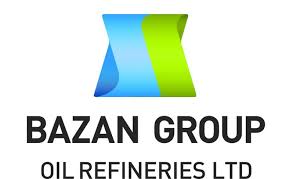
BAZAN Group,, formerly Oil Refineries Ltd., is an oil refining and petrochemicals company located in Haifa Bay, Israel. It operates the largest oil refinery in the country. ORL has a total oil refining capacity of approximately 9.8 million tons of crude oil per year with a Nelson complexity index of 9. ORL provides a variety of products used in industrial operations, agriculture and transportation. ORL is Israel's largest integrated refining and petrochemical facility. The company also provides storage and transportation services for oil fuel products, as well as electricity and steam to industrial customers in the region.

A. O. Smith Corporation is an American manufacturer of both residential and commercial water heaters and boilers, and the largest manufacturer and marketer of water heaters in North America. It also supplies water treatment and water purification products in the Asian market. The company has 27 locations worldwide, including five manufacturing facilities in North America, as well as plants in Bengaluru in India, Nanjing in China and Veldhoven in The Netherlands.
The Audi R8 LMS Cup was a one-make sports car racing series by Audi based in Asia. Audi R8 LMS Cup cars were based on the Audi R8 LMS (GT3).























